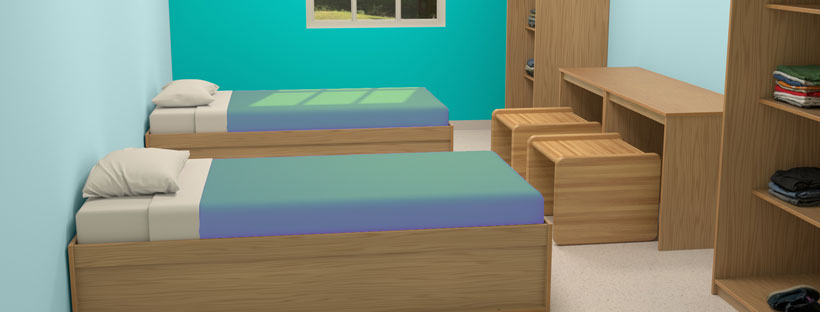
Our environment has a huge influence on our mental and emotional health and well-being. It’s no surprise then that behavioral and mental health facilities are taking a hard look at how the design of patient rooms, lobbies, recreation areas, and other spaces can positively impact the health of clients and patients.
This design approach – called trauma-informed design – has gained momentum over the years as the behavioral health community began to better understand the connections between mental health, healthcare outcomes and the built environment. What we’re now finding is that among all of the elements that go into effective trauma-informed design, smart contract furniture for mental and behavioral health is playing a vital role in its success.
To Understand Trauma-informed Design, We First Need to Understand Trauma-informed Care.
Trauma-informed care approaches emotional healing from the perspective of six core principles – safety, trustworthiness and transparency, peer support, collaboration and mutuality, empowerment, and cultural, historical and gender issues. Its goal is to use these principles to provide a path toward healing and recovery.
Trauma-informed design recognizes these principles and acknowledges the connection between a person’s environment and their outlook, mood, behavior, and, ultimately, their recovery. When designing the interior of a behavioral health center with these principles in mind, determining each space’s layout and specifying the right contract furniture are two of the most important considerations.
How Does Contract Furniture Layout and Selection Play a Role in Healing?
The layout of a room and the configuration of furniture trigger an emotional reaction in a patient’s mind the moment they walk through the door. You can mold this emotional response into a positive one by designing a room layout and furniture configuration that reduce stress and anxiety.
For example, furniture placed between clinicians and patients creates a barrier that communicates dominance and insecurity, triggering a negative emotional response. Instead, furniture layouts that are open, spacious, and provide clear sightlines increase a patient’s sense of safety, reduce the sense of overcrowding and produce a positive, healthy emotional response.
The individual pieces of behavioral health furniture you select are also a key consideration in trauma-informed design. Visual complexity, like patterns, can trigger stress in the brain. Your furniture should have clean lines and simple design patterns to support a calming and nurturing environment. Also, consider the colors and textures of the upholstery you choose to create as comfortable an environment as possible.
How Can a Behavioral Health Furniture Partner Support Trauma-Informed Design?
Having the right contract furniture partner that understands the principles of trauma-informed design can help behavioral health facility managers provide a safe, healthy environment for mental health patients. Here’s what to look for when searching for the right furniture partner.
Floorplan Design Expertise
Prior to recommending specific furniture for your facility, your contract furniture partner should help you with your overall floorplan to make sure your layout is in line with the principles of trauma-informed design. At Blockhouse, for example, we approach trauma-informed design by first gaining an understanding of how clinicians care for their patients.
For instance, if we’re helping lay out a small meeting room for patient counseling sessions, we may suggest lounge chairs and loveseats that are both comfortable and ligature-resistant to create a calming environment that’s also patient-safe. By understanding the particular health center’s needs, we can design spaces to help them deliver the best care.
Customizable Design Capabilities
A contract furniture partner should also offer trauma-informed design pieces that are customizable. We work with each of our customers to customize colors, upholstery, and wood finishes to trauma-informed design standards. Look for simple upholstery, finish and other design options that reduce patient stress and discomfort. You want your furniture’s design to help create a soothing environment.
High-Quality, Durable Fabrics and Finishes
Behavioral health facilities need furniture that holds up to heavy use and can last for decades. Look for a partner that manufactures furniture using high-quality, durable materials constructed for high impact. Every piece of contract furniture we manufacture is built with high-quality woods. Unlike metal and plastic, which can feel cold and institutional, wood is both durable and familiar so mental health patients feel more at ease.
Furniture that Blends Comfort with Safety
Contract furniture for behavioral health facilities should be both comfortable and safe in order to fully aid trauma-informed care. Our behavioral health furniture, for example, is designed to be ligature-resistant, tamper-resistant, and secured to prevent movement. And yet when you sit down in one of our behavioral health chairs, you’ll notice rounded wooden arms and comfortable upholstered cushions. Especially when designing to support trauma-informed care, this blend of comfort and safety goes a long way in supporting patient well-being.
Considering Contract Furniture with Trauma-Informed Design in Mind?
The right contract furniture manufacturer will understand the principles of trauma-informed design and how furniture layout and selection can support healing. At Blockhouse, we incorporate trauma-informed design features into our behavioral health furniture and are ready to help you plan a safe, positive space for your clients and patients. Contact us today. We look forward to working with you.

